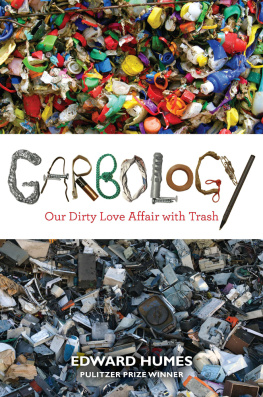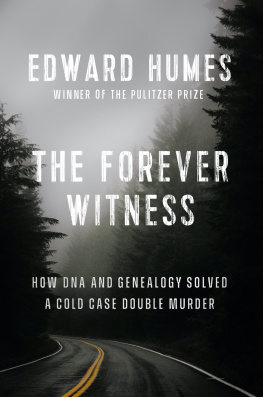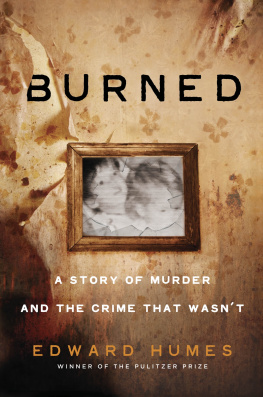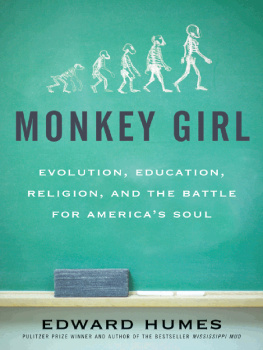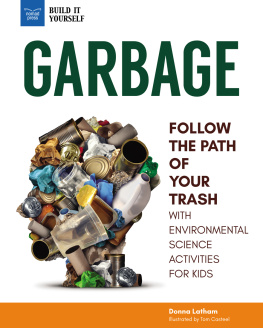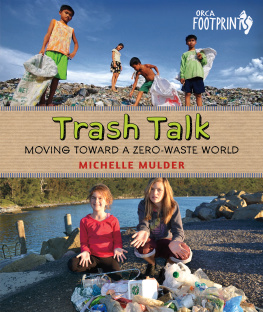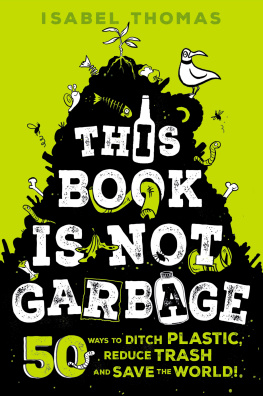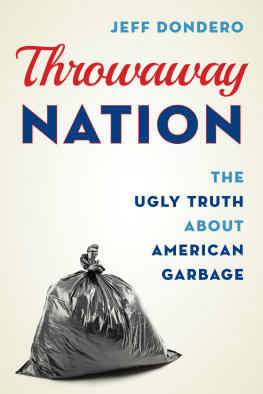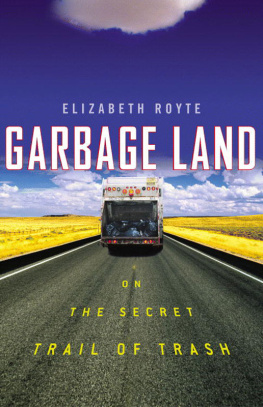GARBOLOGY
ALSO BY EDWARD HUMES
Force of Nature:
The Unlikely Story of Wal-Marts Green Revolution
Mississippi Mud:
Southern Justice and the Dixie Mafia
Eco Barons:
The New Heroes of Environmental Activism
Monkey Girl:
Evolution, Education, Religion, and the Battle for Americas Soul
Over Here:
How the G.I. Bill Transformed the American Dream
School of Dreams:
Making the Grade at a Top American High School
Baby ER:
The Heroic Doctors and Nurses Who Perform Medicines Tiniest Miracles
Mean Justice
No Matter How Loud I Shout:
A Year in the Life of Juvenile Court
Murderer with a Badge:
The Secret Life of a Rogue Cop
GARBOLOGY
OUR DIRTY LOVE AFFAIR
WITH TRASH
EDWARD HUMES
AVERY
a member of Penguin Group (USA) Inc.
New York

Published by the Penguin Group
Penguin Group (USA) Inc., 375 Hudson Street, New York, New York 10014, USA
Penguin Group (Canada), 90 Eglinton Avenue East, Suite 700, Toronto, Ontario M4P 2Y3, Canada
(a division of Pearson Penguin Canada Inc.) Penguin Books Ltd, 80 Strand, London WC2R 0RL,
England Penguin Ireland, 25 St Stephens Green, Dublin 2, Ireland (a division of Penguin
Books Ltd) Penguin Group (Australia), 250 Camberwell Road, Camberwell, Victoria 3124, Australia
(a division of Pearson Australia Group Pty Ltd) Penguin Books India Pvt Ltd, 11 Community Centre,
Panchsheel Park, New Delhi110 017, India Penguin Group (NZ), 67 Apollo Drive, Rosedale,
North Shore 0632, New Zealand (a division of Pearson New Zealand Ltd) Penguin Books
(South Africa) (Pty) Ltd, 24 Sturdee Avenue, Rosebank, Johannesburg 2196, South Africa
Penguin Books Ltd, Registered Offices: 80 Strand, London WC2R 0RL, England
Copyright 2012 by Edward Humes
All rights reserved. No part of this book may be reproduced, scanned, or distributed in any printed or electronic form without permission. Please do not participate in or encourage piracy of copyrighted materials in violation of the authors rights. Purchase only authorized editions.
Published simultaneously in Canada
Most Avery books are available at special quantity discounts for
bulk purchase for sales promotions, premiums, fund-raising, and educational needs.
Special books or book excerpts also can be created to fit specific needs. For details, write
Penguin Group (USA) Inc. Special Markets, 375 Hudson Street, New York, NY 10014.
ISBN: 978-1-101-58037-0
Printed in the United States of America
1 3 5 7 9 10 8 6 4 2
BOOK DESIGN BY TANYA MAIBORODA
While the author has made every effort to provide accurate telephone numbers and Internet addresses at the time of publication, neither the publisher nor the author assumes any responsibility for errors, or for changes that occur after publication. Further, the publisher does not have any control over and does not assume any responsibility for author or third-party websites or their content.
ALWAYS LEARNING
PEARSON
In memory of my grandmother Maggie,
who survived famine, weathered the Great Depression,
drank her Irish whiskey neat, taught me to play poker at age seven,
and instructed me that, while wasting is not exactly a sin,
it is rather stupid
INTRODUCTION: 102 TONS (OR: BECOMING CHINAS TRASH COMPACTOR)
O N M AY 24, 2010, RESCUE WORKERS DONNED IM permeable hazardous materials suits, then burrowed into the creaking, dangerous confines of a ruined South Side Chicago home, searching for the elderly couple trapped inside.
More than an hour later, as curious neighbors gathered and a television news crew arrived to film the emergency rescue operations, Jesse Gaston, a seventy-six-year-old chemist, and his wife, Thelma, a retired schoolteacher, walked unsteadily into the hazy afternoon light, dehydrated and hungry but still among the living.
The Gastons had been trapped by trashtheir own trash.
The debris had accumulated for years until every surface of the house was covered by layers of old newspapers, empty plastic jars, pieces of broken furniture, worn-out coolers, splintered garden rakes, thousands of soda bottles, cans of every size, clothing old and new, broken lamps, dusty catalogs, mountains of junk mail and garbage bags filled with the detritus of daily life. All of this, and much more, had been kept for reasons no one could coherently explain, not even the Gastons, until the junk and trash reached the level of the highest kitchen cupboards, the ones that held the good china. A broken refrigerator lay in the kitchen, half buried and resting on its side, as if buoyed up by the sea of bottles, cans, cartons and sacks engulfing it. No room in the house could be called usable or even safely navigable; the stairs were blocked, the furniture buried, the garage packed floor to ceiling. The disordered accumulation looked as if it had been swept in by a tidal wave.
The Gastons simply grew unable to part with their trash. This hoarding compulsion gripped them gradually, a slow evolution, a piece at a time, then a bag here and there, then whole boxes of trash until, finally, the Gaston home became a one-way depository, the garbage version of the Eagles famous Hotel California: stuff checked in, but it could never leave. They hoarded until goods and trash consumed their home and almost their lives. Neighbors, alarmed by the fact that the couple hadnt been seen in three weeksnot to mention the increasingly persistent stench emanating from the homehad called police and firefighters. The rescuers eventually determined that Thelma had become trapped by falling debris somewhere in the bowels of the house, and Jesse, trying to reach her, had been pinned by piles of trash that toppled around him, too.
Although most of us tend to view this sort of extreme hoarding as an aberration, its a surprisingly common occurrence. Variations of the Gaston household are found around the country more or less on a daily basis, although most often after the hoarders demise, and seldom with the fanfare of news coverage. Somewhere between 3 and 6 million Americans are thought to be compulsive junk hoarders with living spaces that, to varying degrees, resemble the Gastons. The phenomenon offers enough freak-show fascination to have spawned a cable television series: the A&E Networks Hoarders, which entertains viewers by taking them inside different hoarders homes every week. The shows website offers a handy interactive quiz to help viewers determine if they, too, are addicted to hoarding or merely just messy.
This phenomenon has not yet achieved true immortality as a distinct mental illnessthe bible of psychiatry, the Diagnostic and Statistical Manual of Mental Disorders, categorizes extreme hoarding as merely one of many forms of the catch-all obsessive-compulsive disorderalthough some experts are lobbying to have it classified as its own, unique ailment: disposophobia. The proposed malady is alternatively known as Collyer Brothers syndrome, named for one of the earliest and most dramatic manifestations of media-immortalized trash hoarding. Homer and Langley Collyer, rich and reclusive, rebelled early in the twentieth century against the still-evolving practice of mandatory municipal garbage collection in New York City. They turned their multistory brownstone into a crammed and putrefying museum of trash, featuring endless piles and rows of newspapers, bottles, boxes, broken gadgetry (Langley Collyer fancied himself an inventor) and a partially buried Model T Ford hidden on the second floor beneath layers of debris. The brothers were found dead in their home in 1947Langley had been crushed by a collapsing tunnel of trash, and his invalid older brother, Homer, helpless without Langleys care, died later of thirst and starvation. Authorities eventually removed about 130 tons of trash from the brothers home.

